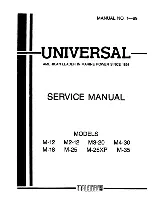
"MAX"
a)
Turn drive
power off.
b)
Connect a DC voltmeter between A1 and A2 motor leads at the motor.
c)
Set meter scale so that rated armature voltage ( 180 volts as noted on motor name
plated
) ma
y be read.
d)
Turn
power on. Turn s
peed control knob full
y clockwise.
e)
Adjust "MAX" trim pot until meter reads name plate rated voltage ( 180 volts)
NOTE: If desired, a tachometer or strobe light may be used in lieu of the DC
voltmeter. Proceed as described above, except adjust the "MAX" trim pot until
tachometer or strobe light indicates that motor is turning at base speed.
"TORQ"
a)
Turn drive
power off.
b)
Connect a DC ammeter (NOT a clamp-on type) in series with the A1 motor lead
between motor and control unit.
c)
Turn
power on.
d)
Set s
peed control knob for a low s
peed
(e.
g., 10% settin
g)
.
e)
Apply friction braking to the motor shaft until until motor stalls out.
CAUTION:
Watch ammeter to assure that control is limitin
g current.
f)
Stall current should read roughtly 150% of rated armature current ( see motor
name
plate
).
g)
If current is to hi
gh, rotate the "TORQ"
pot counter clockwise to decrease.
"ACC"
a)
Accerleration adjustment sets time for
motor to reach set speed.
Adjust to desired acceleration time. Clockwise rotation increases time.
TORQUE LIMIT
Sets the maximum
torque that can be obtained from the motor,
and the maximum armature current that the
control unit will deliver. Torque adjustment
is preset at the factory usually for 150% of
rated motor torque ( current). Clockwise
rotation of the "TORQ" trim pot increases
the torque that the motor will deliver.
Calibrates the speed at which motor turns
when speed control knob is fully clockwise.
Clockwise rotation of the "MAX" trim pot
increases maximum motor speed.












































